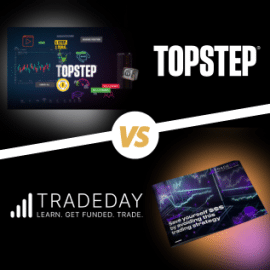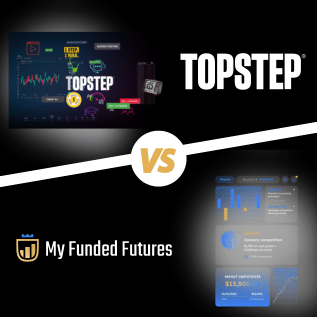Topstep VS TradeDay
Overview
In this piece we compare two leading proprietary trading firms, TradeDay and Topstep, examining the factors to consider when deciding which firm is the better fit for you. While both platforms provide aspiring traders with the opportunity to demonstrate their trading prowess and qualify for funding, they are each tailored to a different set of requirements and levels of experience.
Topstep, an esteemed US prop trading firm, has over a decade of experience in the industry.
The firm works with NinjaTrader, Tradovate and TradingView as its trading platforms and also as brokers. Moreover, Topstep has recently announced its own ground-breaking trading platform, TopstepX™. Drawing upon more than ten years of industry acumen, insights and feedback, the firm has joined forces with top-tier software developers and traders to conceive a cutting-edge trading platform exclusively for Topstep traders. TopstepX™ transcends the traditional trade execution platforms, delivering “the Ultimate Trading Xperience™”, which brings together everything Topstep has to offer in one accessible platform.
Another exciting introduction to Topstep’s features is TopstepTV™, which streams live directly from Topstep’s headquarters every weekday from 8.00am – 3.00pm CT. Topstep traders viewing the broadcasts can learn directly at the hands of seasoned traders as they engage in live trading and delve into recent market movements and trends. Audiences also benefit from updates on economic news, invaluable trading pointers, statistics, rewards for the most successful traders, and appearances from distinguished guests.
Topstep’s account sizes start at $50,000 and rise to $150,000, aimed at traders who are comfortable trading moderate to substantial capital. The evaluation process has only one stage, with profit targets of $3,000, $6,000, or $9,000, depending on account size, and maximum total drawdown limits of $2,000, $3,000 or $4,500. There is a diverse array of instruments available to trade, including CME Equity Futures such as the popular E-mini-S&P 500 (ES) and Micro E-mini versions of major indices such as the S&P, NASDAQ 100, and Russell 2000. For the forex futures traders, instruments like the Australian Dollar (6A), Euro FX (6E), and Japanese Yen (6J) are offered.
TradeDay, led by James Thorpe and Steve Miley, is a futures proprietary trading firm based in the US with a track-record to date of four years. It offers a number of trading platforms, including TradingView, Jigsaw, NinjaTrader and Tradovate, and partners with CME Group for brokerage services. The firm’s account sizes start at $10,000 and go all the way up to $250,000, meaning there is an account for everybody, from newcomers to in the industry through to those with significant experience looking for high levels of funding.
TradeDay’s evaluation process is transparent and simple, with only one stage and the added benefit of a 14-day free trial – an uncommon feature in the industry. Profit targets are between $1,000 and $12,000, depending on the selected challenge, with maximum total drawdowns of between $500 and $4,000, again contingent on account size and challenge. The firm provides traders access to futures on exchanges such as CME, CBOT, NYMEX, and COMEX. Furthermore, traders partnering with TradeDay can trade in simulated markets with no constraints, while also benefitting from a wealth of educational materials on the firm’s website.


| TradeDay is Best for: | Topstep is Best for: |
| Traders who like transparent, straightforward rules. | Beginners hoping to acquire the knowledge they need to succeed. |
| Those who will benefit from an extensive range of educational materials. | Futures traders seeking a lifelike trading simulation. |
| Traders seeking diverse trading instruments. | Those who prioritise educational resources and live sessions. |
| Users who prioritise access to multiple funding platforms. | Traders who lean towards stricter risk management rules to maintain discipline. |
| Traders looking for a generous profit split. | Those requiring support for popular trading platforms. |
Topstep vs. TradeDay: A Comparative Table & Rules
TradeDay and Topstep are both industry-leading platforms with innovative features to help traders make the most of their skills. Both firms offer traders access to the markets without having to put their personal capital at risk. The table below looks at the rules and features of the two firms.
| Feature | TradeDay | Topstep |
| Instruments | Futures contracts (Equity, Forex, Agricultural, Energy, Interest Rate, Metals) | Futures contracts (Equity, Forex, Agricultural, Energy, Interest Rate, Metals) |
| Challenge Types | One-Step | 1-Step/1-Rule |
| Challenge Account Sizes | $10,000, $25,000, $50,000, $100,000, $150,000, $250,000 | $50,000, $100,000, $150,000 |
| Challenge Cost | $99 – $750/month | $125 – $650/month |
| Minimum Trading Days | 10 days | 2 days |
| Max Daily Loss | Varies by program | $2,000 up to $4,500 |
| Max Drawdown | $1,000 to $5,000 | Varies by program |
| Payout Split | 80/20 (trader/firm) | 90/10 (trader/firm) Keep 100% on first $10,000 profits |
| Profit Target | $1,000 to $5,000 | $3,000 to $9,000 |
Additional Points:
Topstep:
- Topstep has only one rule: the maximum loss limit, calculated based on your end-of-day balance (as opposed to using intraday unrealised profits). Breaching the MML counts as a rule violation.
- You can open, up to 5 Express Funded Accounts (XFA)
- Automated XFA Creation within minutes
- The Performance Coaching Plan is available for $395 per month or comes free with funded accounts. Some of its advantages are:
- A 30-minute starter session.
- Guidance that caters specifically to your personal trading style and targets.
- Daily meetings.
- Weekly one-on-one coaching sessions.
- Exclusive access to a group chat for sharing strategies and insights.
Deeper Dive into TradeDay vs. Topstep Trader
The following table takes a closer look at the rules and restrictions put in place by both prop firms.
| Rule Category | TradeDay | Topstep |
| Allowed Instruments | Equity Futures, Foreign Exchange Futures, Agricultural Futures, Energy Futures, Interest Rate Futures, Metals Futures. | Equity Futures, Foreign Exchange Futures, Agricultural Futures, Energy Futures, Interest Rate Futures, Metals Futures. |
| Scalping | Allowed | Allowed |
| Day Trading | Allowed | Allowed |
| Swing Trading | Not Allowed | Allowed |
| Holding Positions Overnight | Not Allowed | Not Allowed |
| Holding Positions Over Weekends | Not Allowed | Not Allowed |
| News Trading | Allowed | Allowed |
1. Max Daily Loss (MDL):
- Topstep: Topstep has a maximum loss limit policy which is calculated from the previous day’s account balance, an approach which works in the trader’s favour. The policy emphasises the significance of strong risk management and discipline. Each account has its own daily loss limit, which if reached leads to the end of your Trading Combine. These daily loss limits are as follows:
- $50,000 Trading Combine: $1,000
- $100,000 Trading Combine: $2,000
- $150,000 Trading Combine: $3,000
- TradeDay: TradeDay prioritises maximum drawdown – see below to find out more.
2. Max Drawdown (MDD):
- Topstep: Topstep focuses on maximum daily loss, as detailed earlier.
- TradeDay:
- TradeDay’s trailing maximum drawdown (TMD) functions as a cap on the maximum loss allowable each day and varies according to program.
- If you breach the TMD while you have an open position, your positions will be liquidated, you won’t be able to trade further, and you will either fail the evaluation or lose your funded account.
- The TMD is a dynamic limit, meaning it adjusts with the growth of your account. As you generate profits, the limit increases. However, if your account balance decreases due to losses the following day, the TMD remains unchanged, as it is maintained at the peak balance your account has reached.
3. Withdrawals:
- Topstep:
- To be eligible for payouts with Topstep, traders need to have traded for five days on which they generated more than $200 in profit. These are known as “winning days”, and don’t necessarily need to be consecutive. Having met this requirement, traders can withdraw 50% of their account balance. To withdraw the full balance, traders need to accumulate 30 winning days. Withdrawals are usually processed in the seven hours after the request is received and take one or two business days to arrive.
- TradeDay:
- Withdrawals from both funded simulated and funded live accounts are unrestricted. No specific trailing maximum drawdown is enforced when funds are transferred from simulated to live accounts – the drawdown is just the funds that are transferred.
- The transition to a funded live account happens when you have accumulated $5,000 in total (gross) profits. These profits encompass all earnings in your trading account, including any that have been withdrawn. However, only the net profits (i.e. gross profits less withdrawals) are transferred to your funded live account. It’s important to be aware that risk limits may be adapted to reflect the trader’s withdrawals and losses).
4. Leverage:
| Leverage Futures | Topstep | TradeDay |
| Futures | 1:1 | 1.1 |
Topstep vs. TradeDay: Pros and Cons
Topstep:
- Evaluation process has one stage with only one single rule.
- Renowned as an industry-leading prop firm with an illustrious record.
- Attractive pricing.
- Diverse range of account sizes.
- Generous profit-sharing framework in which traders retain 100% of their first $10,000 in profits and 90% subsequently.
- Lots of educational material, with complimentary coaching a particularly noteworthy feature.
- Take as long as you need to achieve profit targets.
- TopstepTV™, a ground-breaking feature providing an abundance of trading insights, news, and reactions to the most recent market trends.
- TopstepX™, a bespoke trading platform created exclusively for Topstep traders.
- Using Topstep’s platform could entail extra fees that TradeDay’s doesn’t.
- Some programs impose more stringent maximum daily loss and maximum drawdown limits than TradeDay.
- Topstep’s rules and different types of programs are potentially more difficult to get to grips with.
- Funded traders are classified as professionals and are therefore charged exchange data feeds.
- Qualifying for payouts requires trading for five winning days.
TradeDay:
- One stage evaluation.
- Access to CQG data feed.
- No recurring subscription fees once traders qualify for funding.
- Selection of educational materials offered.
- Immediate access to a live funded account upon passing the evaluation.
- Traders retain all of their first $10,000 in profit, with a 90/10 profit split thereafter.
- Withdrawals available immediately, with no waiting period or restrictions.
- Drawdowns calculated on an End-of-Day basis, rather than after every trade.
- Increase trading size as profits grow.
- 14-day free trial available.
- Restrictions on holding positions overnight and during weekends.
- Less well-established, with a shorter history in the prop trading industry than Topstep.
- Does not offer multiple accounts.
- Funding programs cost more than Topstep’s.
- Limited availability of promotional offers.
Conclusion
Both TradeDay and Topstep provide enticing features for traders seeking funding to trade in the markets. TradeDay offers a direct path to funding through its relatively simple Evaluation Challenge, including plenty of educational support along the way, while Topstep distinguishes itself with its impressive Trading Combine® funding program, compatibility with a broad range of trading platforms including their own tailor-made platform called TopstepX™ designed exclusively for Topstep users as well as the nurturing of a supportive trading community.
Feeling overwhelmed by the choices? This comparison simplifies Topstep VS Apex Trader Funding to help you make an informed decision.
As such, traders valuing a more structured framework through which to advance their careers, as well as easy access to a group of like-minded traders, may find Τopstep to be the best match for them. You can find out more here. On the other hand, there will be traders who prefer TradeDay’s straightforward approach. Ultimately, the information we’ve given here is just to get you started, and you’ll need to learn more about both prop firms, including their programs, costs and regulations before you find the one that’s the best fit for you, your trading requirements, and your goals.















